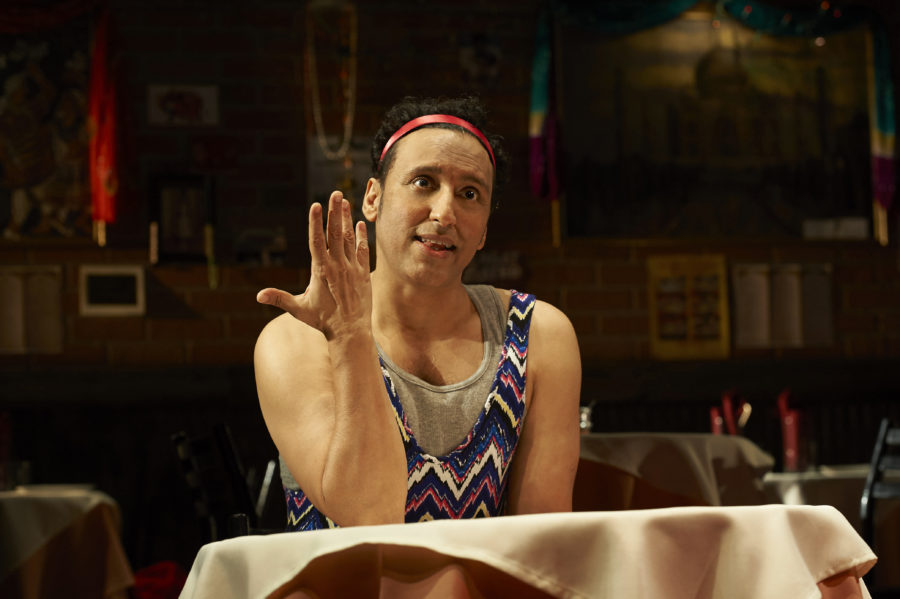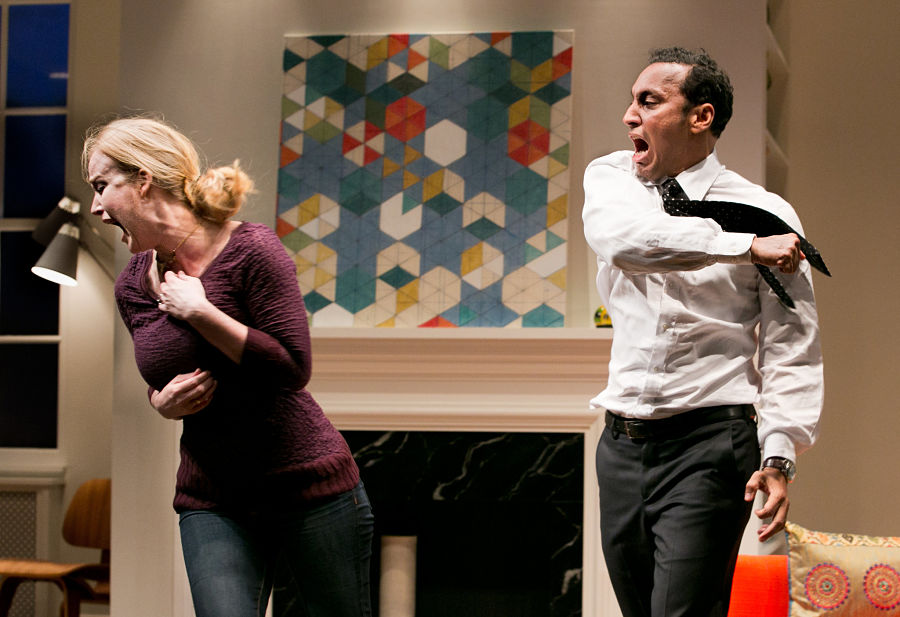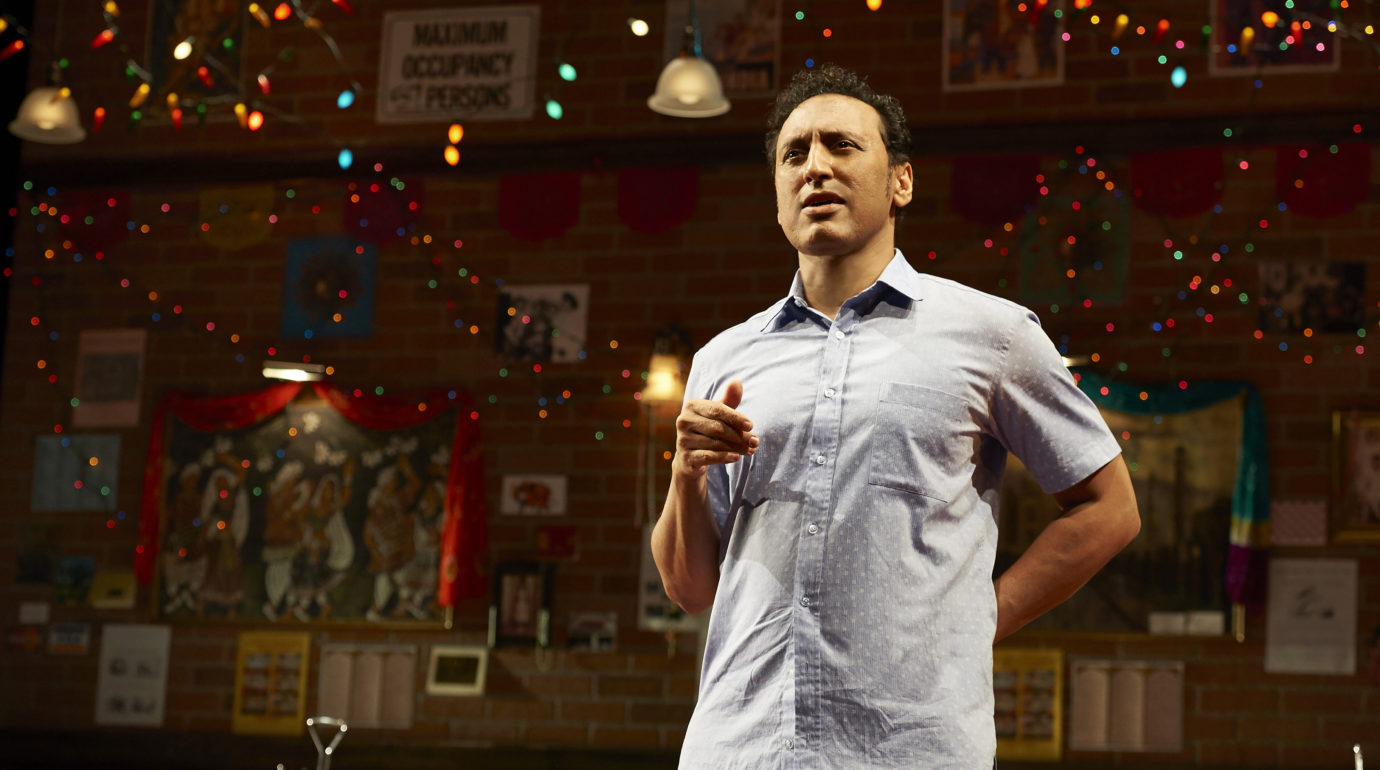Twenty years ago Aasif Mandvi was just another actor in New York, looking for work. But the difference between him and his peers was that Mandvi is Indian, so there were fewer opportunities for him.
“I remember going out to Los Angeles for pilot season and all my white friends were getting pilot auditions and TV show auditions and I literally sat around for four months with not one single audition,” he recalls by phone. “My agents were like, there’s no parts for brown people on TV, at all.”
Frustrated at the lack of authentic representation for “brown” actors, Mandvi penned a one-person show called Sakina’s Restaurant about a group of Indian immigrants working in a New York City restaurant. In it he portrayed an intergenerational group of concerned parents, disgruntled teens, and a hopeful new arrival. Mandvi won an Obie award for the play in 1999.
Things have only gone upward since then. He became a regular correspondent on “The Daily Show with Jon Stewart,” and produced, co-wrote, and starred in the HBO series “The Brink.” And he also starred in Ayad Akhtar’s Pulitzer-winning play Disgraced when it ran at Lincoln Center.
This month Mandvi revisits his younger self, reviving Sakina’s Restaurant at the Minetta Lane Theater. It’s the latest work to be produced by Audible, the audio book producer, as part of its theatrical expansion. After the play finishes its run on Nov. 11, the audio will be available on Audible’s website for download.
I spoke to Mandvi in September about the play and why it’s relevant today, even though it was written in a pre-9/11 world.
DIEP TRAN: Why did you decide to revive Sakina’s Restaurant?
AASIF MANDVI: Audible came to me and said, “We’re getting into live theatre productions. Would you ever be interested in doing Sakina’s Restaurant again, as a revival?” At first I was like, I don’t know, it was done 20 years ago, it was an America before 9/11 and an America before Trump. They were like, “Why don’t you come in and read it to us?” So I actually went in, sat down with the Audible folks, and read the play to them and they responded very positively. And actually, in reading it, I re-familiarized myself with the play and realized there were so many themes in the play, and the emotional story of the show is still resonant today, in the sense that we’re still talking about immigrants and about immigration, more so than we even were back then.
And it’s a reflection on this idea of the immigrant experience and the American dream and what that costs, and the joys and the struggles of that. It felt surprisingly relevant for today. We decided not to update it or anything, and to set it in the time period it’s set in, which is the late ’80s/early ’90s.
You’ve said previously that Sakina, the teenage girl who is more Americanized, has a bit of you. Now that you’re older, do you feel yourself relating to different characters?
Yeah, it’s very interesting to me, because I think I relate to the parents. Before I was writing it, I was looking at it as a kid looking at his parents and writing about them and that experience. But now, as you say that, I realize, yeah, there is a kind of understanding of those characters in a different way. My mother was alive when I did the play originally, and she’s no longer here. There’s something about that also that has a resonance today.

My parents are immigrants too, and I feel like I understand them better as I’ve gotten older, even if I don’t personally agree with all their decisions.
It’s funny, I’m not a father yet, but I have a niece who’s 16. And in a weird way, the father in the play is talking to his 16-year-old daughter and I see my niece who’s 16, she’s posting stuff [on social media] and I’ll say, “That’s completely inappropriate! What the hell is that?” I find myself having that reaction, which is like the father in the play. She’s not even my daughter! I think there’s a maturity and growth that I inhabit today that I’m hoping will inform the play in a whole different way.
You wrote the play because there weren’t characters onstage or onscreen that you could play who weren’t stereotypes. Where do you think we are today in terms of Asian or South Asian representation?
I think we have more representation today, we certainly do. When I wrote Sakina’s Restaurant, there were no brown people onstage, and you didn’t see any brown people in TV or movies. The reason I even wrote it originally was because, there’s no parts for me to play, I’m going to write roles for myself that I want to play. I just decided to start writing these characters based on my family. Thank God for Wynn Handman, who was the artistic director of American Place Theater. He said, “This play should be done and seen and people should see this story of a South Asian immigrant family.” And we did.
Of course today there’s much more representation, but we still find that the sense that what is normal in our culture is white. But look, Crazy Rich Asians, No. 1 movie in the country right now [This interview was conducted in September–Ed.]. So these things are changing, and I think they’re changing in a really positive way.
I like to say that we’ll get to equality when we have mediocre Asians.
Right, and not crazy rich ones. I’ve been doing stand-up, and I’ve been doing a joke about when you tell a story in Hollywood about brown people or black people or any people of color, it’s got to an extraordinary story. It’s got to be the worst thing or the best thing. It’s got to be like, [film trailer voice] “He was born a free man and then he was sold into slavery, and then he got onto a game show and won a million dollars. It’s 12 Years a Slumdog Millionaire!” It’s got to be Crazy Rich Asians, it can’t just be Asians, you know? Having said that, I see scripts and I see what’s happening, I see much more willingness to have diverse characters, to have lead characters who are not white now in a way that was not true when I first wrote Sakina’s Restaurant.
You’re also quite politically active, judging from your Twitter account. As an artist and activist, what do you think the role of art is in these times?
Art and activism can go hand in hand, but they’re not necessarily the same thing. Art can be used as activism but I think art in itself is not about activism. Art in itself is about holding up the mirror. That’s what Disgraced did so well. That’s what I try to do with Sakina’s Restaurant: hold up the mirror and say, this is who we are, this is our experience, this is what it is, you make your own conclusions about it.
Sakina’s Restaurant is not a “political” play. It’s a play, it’s a story, and it will affect you from the perspective of seeing a play about a family that is dealing with the struggles and joys of being immigrants in America. And that in itself will leave you with whatever it will leave you—an identification with that, an understanding, a window. It’s amazing when we first did it, many people would come up to me afterward and say, “This is my story, this is the story of my family.” Whether they were Indians or Asians or Turkish or whatever, it didn’t matter.

It’s funny you mentioned Disgraced, which was quite controversial within the Muslim community.
This was a debate we had a lot when we were doing the play. And the truth is, yes, people were uncomfortable. The agenda was not to make a politically correct statement about Muslims. It wasn’t about, I am now going to present something about Muslims or Islam in a way that is an excuse or vindicates or demonizes or anything. It was a story about a man whose life was falling apart and he was struggling with his own personal identity in that play. What he did at the end play was for some people a horrific act, for some people it was an inevitable act, but it was human and it was flawed. That was what the play was about.
I understand the idea of sometimes we feel like we don’t have enough representation, so the representation that happens needs to be something that we can stand behind and feel proud of. We don’t want our own people criticizing us or making us look bad. That is ultimately not the purpose of the artist; the artist is not actually beholden to that. The artist is beholden to just entertaining and being truthful and trying to tell that story as honestly as he or she can tell it. It’s not about aligning yourself with some kind of agenda.
What do you make of the fact that culturally there’s more diversity, but politically right now there’s less tolerance for immigrants and people of color?
On the one hand, you have much more diversity, much more progressivism happening in the culture. And then the reaction to that is this resistance that I think is represented by Trump and the people who support him. We probably are losing the America that was mostly about white people and was mostly in favor of white men. Are we losing that America? Yes we are. To some people that’s progress, that we are actually having a more inclusive America. For other people that’s a threatening idea.
It’s interesting to me that Trump comes right after Obama. On a macro level, when you get to 30,000 feet and you look down upon this—oh yeah, I can see how Trump comes after Obama. Obama was the point where we all went: Oh yeah, we’ve got a black president! And underneath it was a steaming discontent right under the surface, and that has to do with the changing face of America, a sense that we were losing the Judeo-Christian ideals of what this country was based on. It makes sense on some sort of level that the next step in this evolution is we have to deal with that. We didn’t deal with the shadow, and now the shadow is in the White House.


